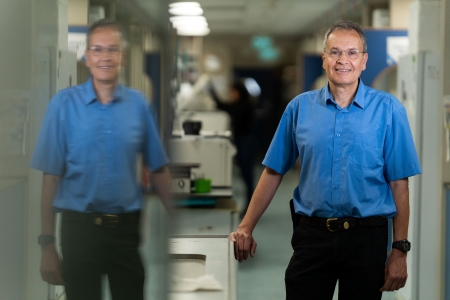
The following article was originally published in the Hadassah International 2022 Year In Review. To access the complete Hadassah International 2022 Year in Review – click here: Cure. Innovation. Humanity.
“For the first time, we now have cells that are absolutely identical genetically, but in both male and female versions.” – Prof. Benjamin Reubinoff, Director, Sidney and Judy Swartz Stem Cell Research Center at Hadassah
Stem cells have been making headlines for the past three decades and for good reason. They are master cells, capable of generating practically any specialized cell in the human body.
Our ability to manipulate and replicate these cells holds tremendous hope for regenerative medicine, safe drug efficacy testing, and more generally, understanding disease development as a whole. Despite the power of these primal building blocks, you may still find yourself struggling to grasp the staggering breakthrough that has permitted scientists to successfully engineer male and female stem cells from the same person, with the exact same genetic code.

The results of the study, led by pioneer stem cell researcher, Prof. Benjamin Reubinoff, together with PhD student Ithai Waldhorn, MD, were recently published in Stem Cell Reports. The research is key to understanding how drugs affect men and women differently. “This is a breakthrough in the field of gender medicine,” says Reubinoff. “The world of medical science today recognizes the great importance of the differences between women and men,” says Prof. Reubinoff alluding to the “one drug fits all” approach that has been prevalent for many years. “The National Institutes of Health in the US has changed its policy in recent years, now requiring that all medical research that it funds be conducted on both sexes equally,” he adds.
People respond differently to an illness and to treatment because of many factors: their gender, their genes, their medical background, to name but a few. “For the first time, we now have cells that are absolutely identical genetically, but in both male and female versions,” says Reubinoff. “This means that we can now compare and contrast how they respond to a medication when all other factors are identical.”
Exploring the differences in how men and women respond to illnesses and drugs is essential. For example, women have a higher risk of developing autoimmune diseases such as multiple sclerosis and rheumatoid arthritis, while men are more likely to have more significant illnesses when infected with COVID-19 and other infectious diseases. There are also differences in cardiac morbidity and various psychiatric disorders. And there are differences between the sexes in the efficacy and side effects of drugs.
Reubinoff is one of the pioneers of human embryonic stem cell (hESC) research. With colleagues from Australia and Singapore, he was the second in the world to derive hESC lines, and the first to show somatic differentiation of the hESCs in culture. The focus of his research is the exploitation of hESCs in regenerative medicine for the treatment of neural and retinal degenerative disorders.
He is the founder and Chief Scientific Officer of Cell Cure Neurosciences Ltd., a biotechnology company focused on the manufacture of specialized stem cells for regenerative medicine in retinal and neural degenerative diseases.
His work on human pluripotent stem cells has led to the development of numerous pioneer programs that are now in clinical trials.
Prof. Reubinoff is the Director of the Sidney and Judy Swartz Stem Cell Research Center of the Goldyne Savad Institute of Gene Therapy at Hadassah.
Stem Cell Treatment for Macular Degeneration

Clinical trials of a Hadassah-born stem cell treatment for macular degeneration are underway with promising results, which show the potential for slowing and even reversing the disease.
A close research collaboration between Prof. Reubinoff and Prof. Eyal Banin, Director of Hadassah’s Center for Retinal and Macular Degeneration uses human embryonic stem cells (hESC) to treat dry age-related macular degeneration (AMD), a retinal disease that is the leading cause of blindness in the Western World. To date, there is no effective treatment to replace the age-induced failing of retinal pigment epithelium (RPE) cells, which leads to dry AMD.
Profs. Reubinoff and Banin were able to develop a technology that allows hESCs to differentiate into RPE cells in culture. Their research was transferred to Cell Cure Neurosciences Ltd., founded with the help of Hadasit, Hadassah’s technology transfer company. Reubinoff and Banin, together with the Cell Cure team, developed OpRegen, a preparation of hESC-derived RPE cells. From initial results obtained in the lab, the OpRegen preparation moved through to the translational research phase including the production of clinical-grade cells at a high level of purity. As part of Phase I/IIa clinical trial that received US FDA approval, a suspension of hESC-derived RPE cells was injected into the subretinal space of patients with advanced dry AMD.
The project was acquired by Lineage Cell Therapeutics, Ltd, which, in turn, has now entered into an exclusive worldwide collaboration and licensing agreement with Roche’s Genentech to develop and commercialize OpRegen for the treatment of the dry form of AMD.
“This has been a unique and thrilling journey,” says Banin. “Few clinician-scientists have the privilege of seeing their work go from basic research to clinical application in patients. The preliminary results of the clinical trials give hope that the technology will delay and even reverse the visual loss associated with dry AMD.”
Main photo caption: Prof. Benjamin Reubinoff, Director of the Sidney and Judy Swartz Stem Cell Research Center of the Goldyne Savad Institute of Gene Therapy at Hadassah
